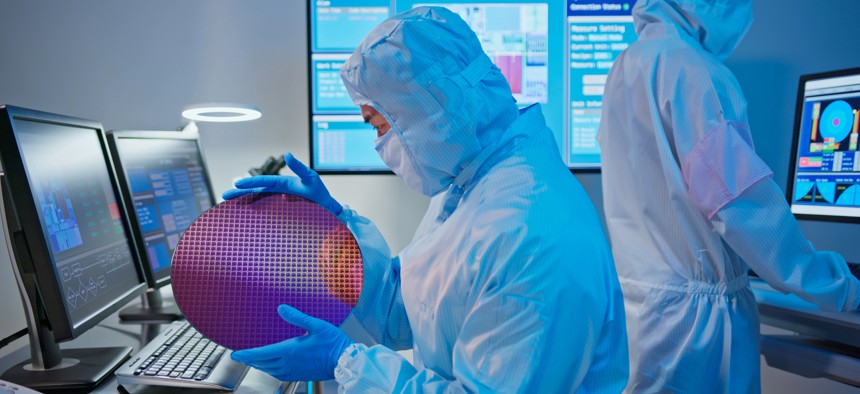States look beyond ‘lab to fab’

PonyWang/Getty Images

Connecting state and local government leaders
A large chip-making facility funded by the CHIPS Act represents an opportunity for state and local leaders to build a technology-based business infrastructure and workforce.
New federal funding to encourage the building of domestic chip-making facilities has state and local officials excited about nurturing an ecosystem around new factories to spawn more opportunities for tech businesses and workers.
But it also represents a challenge for local officials, who may need to make major infrastructure investments to support construction of new factories or encourage chipmakers to repurpose manufacturing sites where utilities are already installed.
Federal officials, who have previously stated that the $54.2 billion CHIPS and Science Act will “live or die by what happens at the local level,” said it is incumbent on governments to focus on improving whole communities, rather than just erecting a big chip-making factory.
"This is not a program to just go and build a couple of factories and call it a day,” Sreenivas Ramaswamy, a senior advisor to the secretary of Commerce, said during an October webinar hosted by the National Institute of Standards and Technology. “It is a program to revitalize the entire domestic semiconductor ecosystem, to improve our national and economic security."
“It’s not just the lab to fab,” Indiana Gov. Eric Holcomb said at an October event hosted by the Washington Post. Rather, local leaders should instead think about how governments can encourage other companies to come in and support the manufacturing effort.
That includes companies that make the silicon wafers, equipment and tools necessary to build chips and the firms that provide the software, some of which may be on-site and others nearby. That means state and local leaders should encourage investment not only in research and development, advanced materials and semiconductor design, but also robotic manufacturing, supply chain security, intellectual property protection and IT infrastructure such as cloud computing, data centers and high-speed networking.
Manassas, Virginia, has been home to a Micron manufacturing facility since 2002, which as well as directly employing around 1,600 people also houses Lam Research, which provides wafer manufacturing equipment and services, and other companies that support Micron’s business.
Patrick Small, Manassas’ economic development director, said while semiconductor plants may not have the economic impact of a steel mill, it still “provides a steady stream of employment and contract opportunities for this entire ecosystem that is the semiconductor industry.”
In an email, Jason El Koubi, president and CEO of the Virginia Economic Development Partnership, said Micron’s site in Manassas “anchors a regional ecosystem of semiconductor manufacturing and innovation that enhances Virginia’s value proposition as a leader in the semiconductor industry.”
During the same Washington Post event, U.S. Sen. Mark Warner (D-Va.) agreed that Micron is a “major anchor” in Northern Virginia, and local leaders elsewhere hope to replicate downstream benefits in their own states.
“I think many of these states, as they make the assessment about going after one of the large manufacturing facilities, are thinking, not only will they get the manufacturing facility, but there will be a series of spin-offs and supply chains that will go into that facility that will have long-term economic benefit,” Warner said.
Meanwhile, the potential for more jobs excites state and local officials too, not only the construction jobs associated with building new facilities, but also the highly skilled technology jobs that support production.
In Northern Virginia, Micron has already demonstrated how a semiconductor plant can bolster workforce development. In an email, El Koubi said the company has funded “growing a talent pipeline of scientists, engineers, and technicians” at local academic institutions including community colleges.
And Holcomb said Indiana already has strong partnerships in place with its high schools and colleges to offer credentials, certifications and other educational programs in a bid to go “deep into the bench” and get students ready to enter the semiconductor workforce.
“This is a holistic effort in terms of opportunities. Thousands of careers that are being put forward that are going to address something that could become crippling if that supply chain becomes supply pain,” he said. “We want it to be supply gain, and we think they can realize that in the state of Indiana.”
But local communities must first invest in the physical infrastructure necessary to support new manufacturing facilities. Micron took advantage of a former IBM facility in Northern Virginia, Small said, so it did not need to have new electricity, water and other utility infrastructure installed.
When Intel recently announced it would build two chip factories in Ohio, Columbus Mayor Andrew Ginther said construction on the nearly 1,000 acre megasite would not have been possible if the city had not agreed to help.
“Intel wouldn't have selected Central Ohio as a location for their expanded operations had the city of Columbus not agreed to provide water and sewer services for the site,” Ginther said during the NIST webinar. “Neighboring New Albany had the land, but we had the utilities, and all of us working in close partnership with the state successfully advanced the best interests of the region.”
Companies looking to build major manufacturing facilities aren’t looking at “a cornfield in the middle of Kansas, 50 miles away from the nearest water and sewer treatment plants,” Small said. Existing infrastructure is a critical part of the decision-making process. “It's not just property,” he added.





